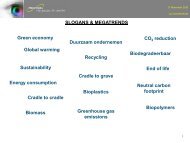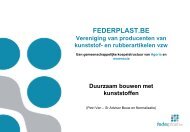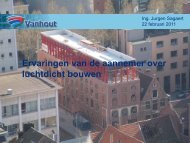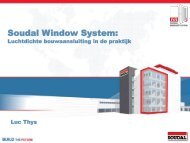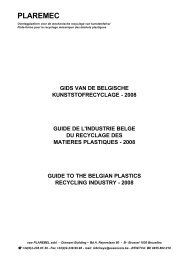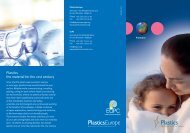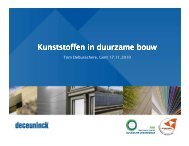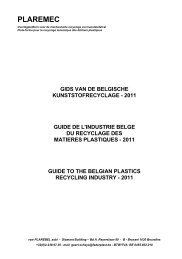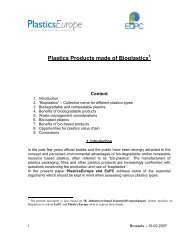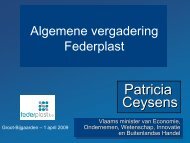Impact of global energy (crude oil) situation on ... - Federplast.be
Impact of global energy (crude oil) situation on ... - Federplast.be
Impact of global energy (crude oil) situation on ... - Federplast.be
Create successful ePaper yourself
Turn your PDF publications into a flip-book with our unique Google optimized e-Paper software.
<str<strong>on</strong>g>Impact</str<strong>on</strong>g> <str<strong>on</strong>g>of</str<strong>on</strong>g> <str<strong>on</strong>g>global</str<strong>on</strong>g> <str<strong>on</strong>g>energy</str<strong>on</strong>g> (<str<strong>on</strong>g>crude</str<strong>on</strong>g> <str<strong>on</strong>g>oil</str<strong>on</strong>g>) <str<strong>on</strong>g>situati<strong>on</strong></str<strong>on</strong>g> <strong>on</strong><br />
plastics development
The ec<strong>on</strong>omic development and demographics<br />
determine the <str<strong>on</strong>g>energy</str<strong>on</strong>g> needs<br />
C<strong>on</strong>sommati<strong>on</strong> d’énergie<br />
par habitant (tep)<br />
9<br />
8<br />
7<br />
6<br />
5<br />
4<br />
3<br />
2<br />
CHINE<br />
1<br />
0<br />
INDE<br />
MONDE<br />
COREE<br />
CANADA<br />
EUROPE<br />
0 5 10 15 20 25 30 35<br />
Source : AIE =Agence Internati<strong>on</strong>ale de l’Energie<br />
PPA= Parité Pouvoir d’Achat OCDE<br />
1960-2001 ou 1971-2001<br />
US<br />
JAPON<br />
PIB/habitant en k$1995 corrigé PPA<br />
2
The <str<strong>on</strong>g>crude</str<strong>on</strong>g> <str<strong>on</strong>g>oil</str<strong>on</strong>g> c<strong>on</strong>sumpti<strong>on</strong> is depending <strong>on</strong> …<br />
family equipment …<br />
800<br />
700<br />
600<br />
500<br />
400<br />
300<br />
200<br />
100<br />
0<br />
Nombre de voitures pour 1000 habitants<br />
1973 1980 1985 1990 1995 2001 2003<br />
Uni<strong>on</strong> Européenne Turquie Etats-unis<br />
Corée du sud Jap<strong>on</strong> Argentine<br />
Chine Inde<br />
3
18<br />
16<br />
14<br />
12<br />
10<br />
8<br />
6<br />
4<br />
C<strong>on</strong>sommati<strong>on</strong> urbaine en<br />
litres aux 100km)<br />
…and pers<strong>on</strong>al choices…<br />
120 140 160 180 200 220 240 260<br />
Vitesse maximale (km/h)<br />
Source: INRETS = Institut Nati<strong>on</strong>al de Recherche sur les Transports et leur Sécurité<br />
4
250<br />
200<br />
150<br />
100<br />
50<br />
… and building & c<strong>on</strong>structi<strong>on</strong> techniques …<br />
0<br />
C<strong>on</strong>sommati<strong>on</strong> kWh/m 2<br />
Avant<br />
1974<br />
- 60%<br />
-85%<br />
1974 1982 1989 2000 2005 L<strong>on</strong>g<br />
terme<br />
5
Demand will c<strong>on</strong>tinue to grow, and gas and <str<strong>on</strong>g>crude</str<strong>on</strong>g> <str<strong>on</strong>g>oil</str<strong>on</strong>g><br />
will remain the main source at short medium term<br />
Milliards de<br />
Tep<br />
16<br />
12<br />
8<br />
4<br />
57%<br />
0<br />
Energy demand growth<br />
+ 60%<br />
10,3<br />
13 %<br />
7%<br />
23 %<br />
21 21 %<br />
%<br />
36 %<br />
60%<br />
16,5<br />
13 %<br />
5%<br />
22 %<br />
25 %<br />
35 %<br />
2002 2030<br />
Hydro +<br />
Renouv.<br />
Nucléaire<br />
Charb<strong>on</strong><br />
Gaz<br />
Pétrole<br />
Milliards de<br />
t<strong>on</strong>nes<br />
Tep = T<strong>on</strong>ne équivalent pétrole<br />
3.7<br />
55%<br />
24 %<br />
8 %<br />
2002<br />
Source: Rapport World Energy Outlook 2004 de l’AIE<br />
Crude <str<strong>on</strong>g>oil</str<strong>on</strong>g>: share <str<strong>on</strong>g>of</str<strong>on</strong>g> transport<br />
5.8<br />
60 %<br />
22 %<br />
5 %<br />
2030<br />
Transport<br />
(carburant)<br />
Pétrochimie<br />
Mat. premières<br />
Chauffage<br />
Électricité<br />
6
Proven reserves <str<strong>on</strong>g>of</str<strong>on</strong>g> fossil fuel and gas will allow to face<br />
this challenge …<br />
1200<br />
1000<br />
800<br />
600<br />
400<br />
200<br />
Réserves prouvées de pétrole et de gaz (Mds <strong>be</strong>p)<br />
Pétrole : réserves<br />
prouvées<br />
1970 1975 1980 1985 1990 1995 2000 2004<br />
Pétrole<br />
Gaz<br />
39<br />
53<br />
28 27 29<br />
Gaz : réserves<br />
prouvées<br />
Réserves prouvées / producti<strong>on</strong> (années)<br />
65 67 68<br />
1970 1980 1990 2000 2004<br />
40<br />
43<br />
Reserves <str<strong>on</strong>g>crude</str<strong>on</strong>g> <str<strong>on</strong>g>oil</str<strong>on</strong>g> & gas:<br />
•Proven: > 2000 Mds <strong>be</strong>p<br />
•Potential additi<strong>on</strong>al: > 1000<br />
Mds <strong>be</strong>p<br />
• Proven reserves are growing thanks to technology and investments<br />
• Investments are a must for producti<strong>on</strong> capacity development<br />
<strong>be</strong>p= baril équivalent pétrole<br />
Reserves more<br />
important for gas<br />
than <str<strong>on</strong>g>crude</str<strong>on</strong>g> <str<strong>on</strong>g>oil</str<strong>on</strong>g><br />
7
Peak <str<strong>on</strong>g>oil</str<strong>on</strong>g> ?…<br />
120<br />
100<br />
80<br />
60<br />
40<br />
20<br />
0<br />
Producti<strong>on</strong><br />
en Mb/jour Sel<strong>on</strong> rapport WEO<br />
de l’AIE en 2005<br />
Réserves<br />
prouvées<br />
2005<br />
1950 1960 1970 1980 1990 2000 2010 2020 2030 2040 2050 2060 2070<br />
Sources: AIE; TOTAL<br />
Demande 1%<br />
Demande 1,5%<br />
8
Taking into account this <str<strong>on</strong>g>global</str<strong>on</strong>g> <str<strong>on</strong>g>energy</str<strong>on</strong>g> <str<strong>on</strong>g>situati<strong>on</strong></str<strong>on</strong>g>,….<br />
Are plastics eco-efficient and a correct<br />
use <str<strong>on</strong>g>of</str<strong>on</strong>g> <str<strong>on</strong>g>of</str<strong>on</strong>g> natural resources ?<br />
9
The answer: Life Cycle Thinking!<br />
10
Cradle: Does plastic influence <str<strong>on</strong>g>oil</str<strong>on</strong>g> and gas<br />
availability?<br />
Transport<br />
45%<br />
NO!<br />
Other (n<strong>on</strong><str<strong>on</strong>g>energy</str<strong>on</strong>g><br />
use)<br />
5%<br />
Heat, electricity<br />
and <str<strong>on</strong>g>energy</str<strong>on</strong>g><br />
42%<br />
Plastics<br />
4%<br />
Chem/<br />
petrochem<br />
feedstock<br />
4%<br />
11
Grave: Recycling and Energy Recovery across EU25+NO/CH<br />
2006<br />
Recycling Energy recovery<br />
12
A new opportunity<br />
Plastics use 4% <str<strong>on</strong>g>of</str<strong>on</strong>g> total <str<strong>on</strong>g>oil</str<strong>on</strong>g><br />
Significant c<strong>on</strong>tributi<strong>on</strong> to <str<strong>on</strong>g>energy</str<strong>on</strong>g><br />
saving & Co2 reducti<strong>on</strong> targets<br />
Plastics in use save each year 5,150 Milli<strong>on</strong> Giga Joules in EU 25.<br />
13
Plastics in use save each year<br />
5,150 Milli<strong>on</strong> Giga Joules in EU25.<br />
This is the equivalent <str<strong>on</strong>g>of</str<strong>on</strong>g> 120 Milli<strong>on</strong>s t<strong>on</strong>s<br />
<str<strong>on</strong>g>of</str<strong>on</strong>g> <str<strong>on</strong>g>oil</str<strong>on</strong>g> or 216 giant tanker queuing a<br />
c<strong>on</strong>tinuous line <str<strong>on</strong>g>of</str<strong>on</strong>g> 99 kilometers.<br />
… or 10 % total EU 25<br />
<str<strong>on</strong>g>energy</str<strong>on</strong>g> c<strong>on</strong>sumpti<strong>on</strong> in<br />
2002<br />
14
Transport<br />
• Innovative products make it possible to cut CO2<br />
emissi<strong>on</strong>s and <str<strong>on</strong>g>energy</str<strong>on</strong>g> c<strong>on</strong>sumpti<strong>on</strong>:<br />
• Plastics are light<br />
– Weight savings resulted in an average<br />
fuel c<strong>on</strong>sumpti<strong>on</strong> cut <str<strong>on</strong>g>of</str<strong>on</strong>g> 750 liters per<br />
life span <str<strong>on</strong>g>of</str<strong>on</strong>g> 150, 000 km<br />
– On a year basis thanks to plastics, Fuel<br />
c<strong>on</strong>sumpti<strong>on</strong> <str<strong>on</strong>g>of</str<strong>on</strong>g> cars is reduced by 12<br />
Milli<strong>on</strong>s T<strong>on</strong>s and CO2 emissi<strong>on</strong>s by 30<br />
Milli<strong>on</strong>s T<strong>on</strong>s.<br />
• Plastics allow aerodynamics design (lower<br />
Cx) resulting in lower c<strong>on</strong>sumpti<strong>on</strong>.<br />
15
Transport<br />
• The Airbus 380 has<br />
22% carb<strong>on</strong> fibre<br />
plastic composites<br />
giving a 15% fuel<br />
saving<br />
• The % will grow up<br />
to 50% for the Boeing<br />
787 Dreamliner<br />
16
Plastics packaging: When more is less<br />
On average <strong>on</strong>ly 1 to 3% <str<strong>on</strong>g>of</str<strong>on</strong>g> the weight <str<strong>on</strong>g>of</str<strong>on</strong>g> a packaged product in<br />
plastics comes from the packaging:<br />
•A plastic film <str<strong>on</strong>g>of</str<strong>on</strong>g> 2g packages 200g <str<strong>on</strong>g>of</str<strong>on</strong>g> cheese<br />
•A plastic Bottle <str<strong>on</strong>g>of</str<strong>on</strong>g> 35g packages 1,5 liter <str<strong>on</strong>g>of</str<strong>on</strong>g> drinks<br />
Inclusive the logistic packaging it grows up to 3,56% <strong>on</strong><br />
average<br />
PLASTIC<br />
POUCHES<br />
3.56%<br />
IS PACKAGING<br />
GLASS JARS<br />
36% IS<br />
PACKAGING<br />
Without plastics, retailers’ fleets would make 50% more journeys<br />
17
Enabling the ‘positive <str<strong>on</strong>g>energy</str<strong>on</strong>g>’ home<br />
PVC<br />
Triple<br />
Glazing<br />
Central ventilati<strong>on</strong><br />
stati<strong>on</strong> with heat<br />
recuperati<strong>on</strong><br />
Fuel Cell<br />
PUR<br />
Ro<str<strong>on</strong>g>of</str<strong>on</strong>g> insulati<strong>on</strong><br />
Latent<br />
Heat Storage<br />
Plaster<br />
Solar<br />
Panel<br />
EPS<br />
Insulati<strong>on</strong><br />
18<br />
Quelle: BASF
What if we would substitute plastics by other material<br />
where possible ?<br />
Energy needed to produce use and<br />
recover plastics in western EU:<br />
3900 Milli<strong>on</strong>s GJ/year<br />
+ 26 %<br />
or + 1020 Milli<strong>on</strong>s GJ/year<br />
Energy needed in case <str<strong>on</strong>g>of</str<strong>on</strong>g> substituti<strong>on</strong>,<br />
even partial:<br />
4920 Milli<strong>on</strong>s GJ/year<br />
1020 M GJ/year represent 22.4 Milli<strong>on</strong>s t<strong>on</strong>s <str<strong>on</strong>g>of</str<strong>on</strong>g> <str<strong>on</strong>g>oil</str<strong>on</strong>g>, or:<br />
• Heating and warm water for 40 milli<strong>on</strong>s people (half <str<strong>on</strong>g>of</str<strong>on</strong>g><br />
Germany)<br />
19
What if we would substitute plastics by other<br />
material where possible ?<br />
CO 2<br />
CO2 emissi<strong>on</strong>s to produce, use,<br />
and recover plastics in<br />
Western EU:<br />
173 Milli<strong>on</strong>s t/year<br />
+ 56 %,<br />
or 97 Milli<strong>on</strong>s t<strong>on</strong>s/year<br />
CO 2<br />
CO 2 emissi<strong>on</strong>s in Western EU<br />
in case <str<strong>on</strong>g>of</str<strong>on</strong>g> substituti<strong>on</strong>, even<br />
partial:<br />
270 Milli<strong>on</strong>s t/year<br />
97 Milli<strong>on</strong>s t/year represent a CO 2 emissi<strong>on</strong> reducti<strong>on</strong> equivalent to:<br />
• 30% <str<strong>on</strong>g>of</str<strong>on</strong>g> Kyoto reducti<strong>on</strong> objectives for EU 15 in the period 2000-2012 (319<br />
Mt/year)<br />
• Total CO2emissi<strong>on</strong>s <str<strong>on</strong>g>of</str<strong>on</strong>g> 90% <str<strong>on</strong>g>of</str<strong>on</strong>g> cars in Germany<br />
20
Renewable energies are <strong>on</strong>ly feasible with plastics<br />
21
Renewable energies are <strong>on</strong>ly feasible with plastics<br />
22
Plastics and disease preventi<strong>on</strong><br />
In recent years, the evoluti<strong>on</strong> <str<strong>on</strong>g>of</str<strong>on</strong>g><br />
plastic materials has progressed<br />
hand in hand with health care<br />
developments. Scientists have<br />
developed new devices such as<br />
syringes, blisters, catheters, fluid<br />
bags, heart valves and others to<br />
restore functi<strong>on</strong>ality in hearts,<br />
b<strong>on</strong>es, kidneys, ears and eyes.<br />
Plastic is an ideal material for these advances as it is aseptic,<br />
guaranteeing biocompatibility with the human body as well as safety<br />
and hygiene. Plastics are also a crucial comp<strong>on</strong>ent in hi-tech<br />
equipment and in machinery used in hospitals and medical research,<br />
as well as in animal care and veterinary sciences.<br />
23
Span <str<strong>on</strong>g>of</str<strong>on</strong>g> life time 120-130 years?<br />
• Furthermore, thanks to polymeric biocompatible<br />
soluti<strong>on</strong>s, it is possible to apply rec<strong>on</strong>structive soluti<strong>on</strong>s<br />
for b<strong>on</strong>es and tend<strong>on</strong>s and perform micro-sounds.<br />
24
Span <str<strong>on</strong>g>of</str<strong>on</strong>g> life time 120-130 years?<br />
• Development <str<strong>on</strong>g>of</str<strong>on</strong>g> Robots<br />
25
Nanotechnologies<br />
EPS + Graphit = Neopor ®<br />
IR-Absor<strong>be</strong>r<br />
Graphit<br />
Source: BASF<br />
26
The trick: Absorpti<strong>on</strong>/reflecti<strong>on</strong> <str<strong>on</strong>g>of</str<strong>on</strong>g> IR radiati<strong>on</strong><br />
Low density,<br />
thin membranes<br />
(
Exp<strong>on</strong>ential technology development<br />
• In the past decades, plastic materials have revoluti<strong>on</strong>ised the way<br />
we communicate, travel, play sport, and protect our health and<br />
envir<strong>on</strong>ment.<br />
• Versatile and eco-efficient, plastic plays an active role in scientific<br />
and technological innovati<strong>on</strong>s aimed at improving our quality <str<strong>on</strong>g>of</str<strong>on</strong>g> life.<br />
• Plastic is present in more complex and challenging applicati<strong>on</strong>s such<br />
as nanotechnology, as well as in everyday objects such as mobile<br />
ph<strong>on</strong>es.<br />
• From aerospace and electr<strong>on</strong>ics to architecture to transport and<br />
smart packaging to sports to medicine, there is no sector where<br />
plastic has not c<strong>on</strong>tributed to soluti<strong>on</strong>s unimaginable even few years<br />
ago.<br />
• Its never-ending, amazing, dynamic evoluti<strong>on</strong> makes plastic the<br />
material for the 21st century<br />
28



